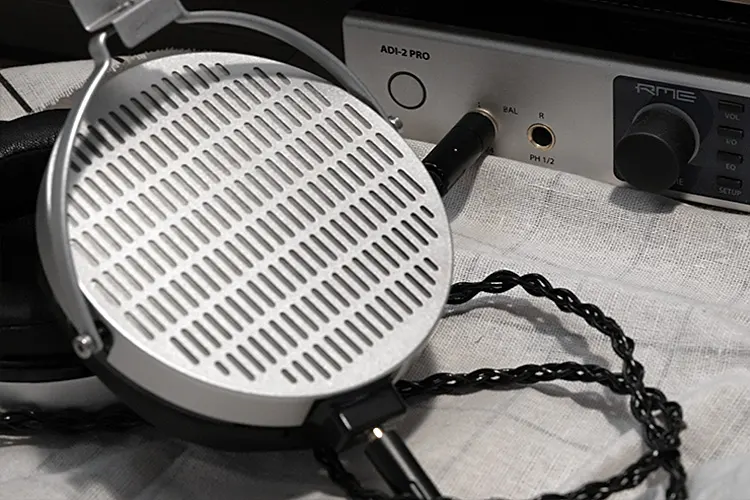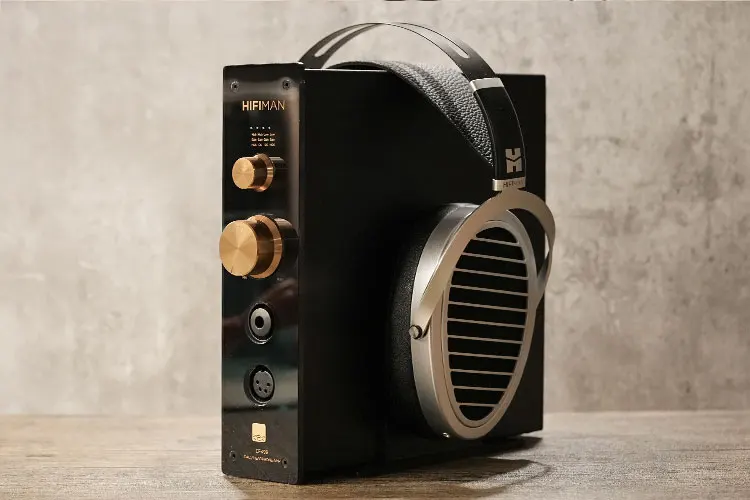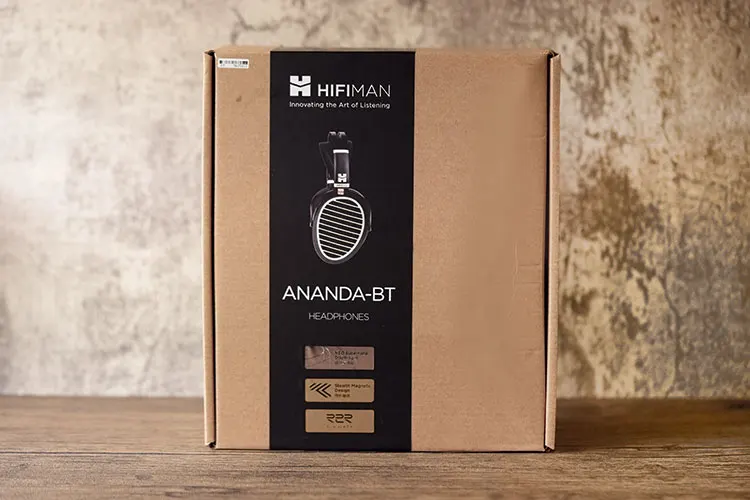Select Comparisons
Moondrop COSMO
Technical
The open-back designed MOONDROP COSMO features a 100mm FDT driver with an etched pure silver thin film circuit and a diaphragm thickness of just 0.500n, which is even thinner than the one on the ANANDA-BT R2R.
It has a relatively low impedance rating of 15Ω±15% (@1kHz) and a sensitivity rating of 100 dB/Vrms (@1kHz), equivalent to 88 dB/mW. This is less sensitive than the ANANDA-BT R2R and requires powerful amping to drive it properly.
Design
The COSMO follows Moondrop’s industrial design language and has round earcups. The design is quite clean compared to the more contrasty colors on the ANANDA-BT R2R and weighs around 550g, slightly heavier than the ANANDA-BT R2R’s 450g (1lb) rating.
Both designs are unique and I find both of them quite comfortable. However, if you are looking for portability the lighter ANANDA-BT R2R is better suited.
Performance
When tested with the FiiO K19, the COSMO demonstrates a fast, mids-centric sound profile with textured details across the spectrum and precise instrument positioning.
In comparison, the ANANDA-BT R2R also excels in the midrange but leans more towards higher frequencies, while its mid-lows are not as robust as those of the COSMO.
The COSMO empowers darker voices with depth, whereas the ANANDA-BT R2R leans towards a brighter, cleaner sound profile with lighter attacks in the subs, ideal for higher-pitched vocals and faster-paced music.
You get a more rounded sound that complements powerful, sharper amplification with the COSMO, while the ANANDA-BT R2R elevates upper vocal frequencies and bass for increased clarity and airiness.
This boost in dynamics during playback strengthens the dynamics and it sounds sharper, and more contrasty than on the COSMO. The ANANDA-BT R2R also features a more colored and intricate harmonic presentation, adding texture, albeit at the expense of some accuracy and control.
The price for the two headphones is quite close but bear in mind that the COSMO requires powerful amplification and the ANANDA-BT R2R sounds euphonic out of the box.
If you already have a powerful setup the upper limit in terms of perceived technicalities and resolution on the COSMO is higher, especially if your library consists of lossless tracks with excellent dynamic range and detail.
Final UX3000
Technical
The Final UX3000 is an entry-level wireless headphone with ANC features. I am including it in the comparison to see how it fairs against the ANANDA-BT R2R which targets audiophile users instead of the mass market.
The UX3000 supports up to 35 hours of playback on a single charge and supports Qualcomm aptX Low Latency Codec for Bluetooth transmission.
Unlike the ANANDA-BT R2R, it does not feature LDAC support. The ANANDA-BT R2R only supports up to 10 hours of playback so we can see how much more power goes into decoding and amplification.
The UX3000 offers multi-point connection, noise-cancellation, and volume control buttons that are better for commutes and calls. The niche-positioned ANANDA-BT R2R offers a different set of features that target those who seek higher playback quality.
It is an interesting comparison as they do not overlap and in fact, the ANANDA-BT R2R does open up some new scenarios to enjoy higher-quality wireless music playback indoors.
Design
The UX3000 has a foldable design and is quite a bit smaller. And of course, it has a closed design with ANC so isolation is much stronger compared to the open-back ANANDA-BT R2R.
There are more metallic elements used on the ANANDA-BT R2R due to its premium positioning and the need to secure the planar components in place, so the build feels more solid on the ANANDA-BT R2R. Still, final does a great job with the surface textures and the molding quality is awesome.
Compared to most wireless headphones the ANANDA-BT R2R is quite a bit more comfortable with its larger ear-cups but of course, you will need to listen in a relatively quiet place.
Performance
The R2R decoding and planar technology used in the ANANDA-BT R2R give it a significant advantage in the sound department, particularly in terms of bass power and response speed.
The smaller diaphragm size of the UX3000 limits the bass depth and power and cannot match the speed of the planar drivers in the ANANDA-BT R2R.
Vocal separation is much more noticeable on the ANANDA-BT R2R compared to the more forgiving, flatter tuning of the UX3000.
In the mid-low, the ANANDA-BT R2R sounds clearer, more defined, and layered. Furthermore, the open-back design of the ANANDA-BT R2R creates a more open and airy sound.
While the UX3000 allows for connecting with 3.5mm cables as a backup option for when the power runs out, the ANANDA-BT R2R can be connected to a USB source and decode on its own, providing higher quality output. Its distortion control is noticeably better, especially at higher volumes.
The experience with these two headphones is very different, with each excelling in different areas. One clear drawback of the ANANDA-BT R2R is its shorter playback time compared to typical wireless headphones, even though it has been enhanced to 10 hours from the previous version.
The open-back design not only leaks ambient noise into the earcups but also allows sound to escape outward, though it also allows the design to sound much more expansive with the treble effortlessly extended.
HIFIMAN ANANDA NANO
Technical
There is a similar design language adopted for the two headphones except that there is a mic, R2R, and BT receiving modules built into the earcups of the ANANDA-BT R2R.
I focused on the sound difference to see what it takes for the wired ANANDA NANO to sound better than the wireless ANANDA-BT R2R connected to a Bluetooth source.
Design
While the two headphones look nearly identical in design, they fit different usage scenarios. For example, the addition of a mic on the ANANDA-BT R2R allows you to TeamSpeak or do conference phone calls with ease.
The rest are similar, even the carrying case. It is noteworthy that it is much more convenient to put the ANANDA-BT R2R headphones back in storage without any cables.
Performance
It may be easy to jump to the conclusion that wired headphones have more potential to step up with cable rolling or pairing with stronger decoders and amplifiers.
However, the ANANDA-BT R2R poses a good threat to these traditional setups as it sounds pretty convincing out of the box and performs better compared to the ANANDA NANO plugged in on my MacBook Air M2 directly.
Comparing the ANANDA NANO connected to the RME ADI-2 to the ANANDA-BT R2R, the ANANDA-BT R2R sounds less controlled and balanced, although it is more organic in the vocal range and has a richer, denser timbre.
The mid-bass on the ANANDA-BT R2R feels elevated to enhance dynamics, while the treble is brighter, leading to a stronger perceived clarity.
The ANANDA NANO sounds more balanced and rounded, even though it may feel less elaborate in the vocal frequencies since it does not sound as colored and thickened as the ANANDA-BT R2R. Nevertheless, the ANANDA NANO still sounds comparatively more extended and detailed.
When connecting the ANANDA NANO via balanced output to the FiiO K19, the dynamics are further strengthened and the vocal character is stronger, sounding more upfront and outlined.
The higher power in amplification helps push the limits and the bass kick is even more responsive, with stronger vocal separation.
The ANANDA-BT R2R can also be connected via USB cable to sound more refined, and arguably the more vocal-favored tuning is preferable on the ANANDA-BT R2R for streaming content.
My Verdict
The HIFIMAN ANANDA-BT R2R has nicely stepped up from its predecessor to offer R2R, planar technology, open-back design, and LDAC connectivity all at once.
There are very few headphones like this yet and it has unlocked quite a few different usage scenarios with the flexibility to untie from the desktop setup or wired portable stack.
The ANANDA-BT R2R manages to capture the merits of planar designs and R2R decoding very nicely with a convincing organic sound profile that also comes with solid bass and satisfactory detail retrieval power, even more so when you plug it into USB Audio sources.
If you love the organic presentation from R2R decoding and want to enjoy high-quality playback without the need to manage a few devices or wires, then the ANANDA-BT R2R headphones would be a solid candidate.
HIFIMAN ANANDA-BT R2R Technical Specifications
- Frequency Response: 8Hz – 55kHz
- Impedance: 25Ω
- Sensitivity: 103dB
- Weight: 1lb
- Charging Time: 2.7 hours
- Play Time: 10 hours
- Bluetooth Version: Bluetooth 5.1
- Bluetooth Profile: HFP, HSP, A2DP, AVRCP
- Audio Codec: aptX, aptX HD, LDAC, AAC, SBC
- Transmission Power: Class 2 (+6dBm)
- Transmission Range: 2.4GHz
- Maximum Communication Distance: 10m





